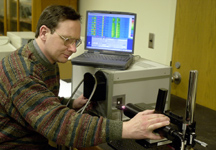 Purdue News
Purdue News
 Purdue News
Purdue News

|
|
July 20, 2001 New portable machine takes chemical imaging
|

|
A new, portable instrument developed by Purdue University chemists will allow researchers to analyze the chemical content of a wide variety of materials in the field – whether it's a laboratory, classroom, doctor's office or farm field.
The instrument, called a portable Raman imaging microscope, or PRIM, is designed for advanced materials diagnostics. It uses laser light to "read" the distribution of chemicals present in a sample in real time, providing a detailed chemical analysis in seconds.
"What makes this instrument unique is that it is portable," says Dor Ben-Amotz, professor of chemistry and PRIM co-creator. "It will allow us to take chemical imaging techniques to places we could not take them before, and it can be used in a variety of environments."
In addition, the new instrument allows a sample to be directly viewed while it is being tested, similar to looking at a sample under a microscope.
"This instrument serves as a sort of hybrid of commercial chemical-analysis instruments and conventional microscopes," Ben-Amotz says. "Many people want to put something under a microscope to see it in detail. Now, we're adding to that process the ability to chemically identify the components in a sample."
Although a number of Raman microscopes currently on the market can be used to identify chemical components in a sample, they require placing the sample on a stage for alignment and focus.
PRIM can be used to study samples that cannot be placed on a microscope stage, because they are too large, immobile or otherwise constrained, such as mixtures in a vat, Ben-Amotz says. It also may be used to collect data through glass or plastic packaging, a process that may be useful when working with hazardous materials.
Potential uses for the instrument include providing real-time chemical analyses of soils, minerals, cements or other chemical mixtures, and producing robotic vision and automated manufacturing systems. The instrument also may someday be used in medical applications, such as biomedical research on chemical processes occurring in living cells and scans of skin surfaces to detect biochemical changes that may serve as markers for cancer.
The prototype machine was developed by Ben-Amotz with the help of Yanan Jiang of SpectraCode Inc. and Hartmut Hedderich, director of Purdue's chemistry laser facility. It is being made available to researchers at Purdue and is currently being used in a wide range of applications, including drug development and analyzing the surface of nano-sized structures.
The 40-pound instrument employs a laser probe head, or "gun," designed to turn 90 degrees in any direction, to excite the molecules in a sample. A computer connected to the probe head quickly analyzes the data and displays the results on the computer screen.
"It's like having a robot with eyes capable of seeing the chemical structure of what it is looking at," Ben-Amotz says. "Instead of saying this is a piece of plastic, it says this is a piece of plastic made of high-density polyethylene."
The prototype for PRIM was funded by the Purdue materials consortium. Ben-Amotz and Hedderich are now developing a second version of PRIM that will be capable of reading samples with greater accuracy.
PRIM follows on the heels of an instrument developed last year at Purdue to map at high speed the distribution of chemicals present in a sample. That instrument, called NIRIM, enabled researchers to analyze composite materials thousands of times faster than other methods.
Developed in collaboration with SpectraCode Inc., a company located in Purdue's Research Park, the instruments work by measuring the wavelengths of light produced when a laser interacts with molecules in a sample and creates molecular vibrations. Because each molecule has a unique vibration pattern, determined by its chemical structure, the resulting color spectrum can be used to fingerprint different types of chemicals in the sample.
Ben-Amotz, who serves as vice president of SpectraCode, says the company plans to make portable devices similar to PRIM commercially available.
Sources: Dor Ben-Amotz, (765) 494-5256; bendor@chem.purdue.edu
Hartmut Hedderich, (765) 494-6543; hhedderi@omni.cc.purdue.edu
Writer: Susan Gaidos, (765) 494-2081; sgaidos@purdue.edu
Purdue News Service: (765) 494-2096; purduenews@purdue.edu
PHOTO CAPTION:
Hartmut Hedderich, director of Purdue's laser facility, uses Purdue's new portable Raman imaging instrument, or PRIM, to analyze the chemical makeup of a medicine sample. By pointing the laser "gun" at the sample, the laser light creates molecular vibrations in the molecules of Tylenol. The resulting color spectrum, which serves as a "fingerprint" of the chemicals, is shown on the computer screen. (Purdue News Service Photo by David Umberger.)
A publication-quality photograph is available at the News Service Web site and at the ftp site. Photo ID: BenAmotz.PRIM
 To the Purdue News and Photos Page
To the Purdue News and Photos Page